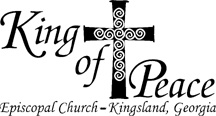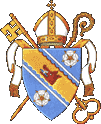The Martyrs of Japan
We remember today The Martyrs of Japan, whose feast day of February 5, was transferred this year as the 5th was a Sunday. Their story is from 1597, when the absolute ruler of Japan, Toyotomi Hideyoshi, sentenced 24 Christians to die. They would be marched to Nagasaki, center of Japanese Christianity where they were to be placed on crosses and then speared to death. The six European missionaries together with some of their converts were to serve as a warning to all Japanese Christians.
At the time these Christians were sentenced to death, the 24 were the tiniest fraction of the estimated 300,000 baptized Christians in Japan. The ruler of Japan feared European colonialism more than Christianity, but he sought nonetheless to kill off Christianity in his nation.
 On the march to Nagasaki, two Christians dared to openly encourage the condemned Christians. For their encouragement, those two were sentenced to death, bringing the total of martyrs to 26. The youngest of the group were 12-year-old Louis Ibaraki and 13-year-old Thomas Kozaki. Father Francis Blanco wrote of the youngest of the group on the eve of execution, “We have little Louis with us and he is so full of courage and in such high spirits that it astonishes everybody.”
On the march to Nagasaki, two Christians dared to openly encourage the condemned Christians. For their encouragement, those two were sentenced to death, bringing the total of martyrs to 26. The youngest of the group were 12-year-old Louis Ibaraki and 13-year-old Thomas Kozaki. Father Francis Blanco wrote of the youngest of the group on the eve of execution, “We have little Louis with us and he is so full of courage and in such high spirits that it astonishes everybody.”
Each of the martyrs had a custom made cross and the boys arrived at the site looking for the smaller ones, meant for them. Each of the condemned men literally embraced their crosses before lying out on them. One by one the prisoners were fixed to the poles. No nails were used. Hands and feet and neck were kept in position with iron rings and a rope around the waist kept the victim tightly bound to the cross.
Once the martyrs had been tied to the crosses, all twenty-six were lifted simultaneously and dropped into the ground with a thump. Father Paul Miki straightened himself on his cross, looked at the crowds and said in a loud voice:
The executioners worked their way along the line of crosses, quickly killing each man in turn, in many cases silencing voices still praising God in song.
The hillside became a pilgrimage site. This situation continued until 1619, when the executioner cut down the martyrs' trees. Then more than 650 Christians and missionaries were put to death on the same hill of Nishizaka and its surroundings.
Even with 650 crucifixions, the church did not die in Nagasaki. Forced underground, the Christian message was passed from parents to children verbally. With no books or formal teaching, Christianity remained underground, passed along this way for 276 years. When Christianity was no longer persecuted the church resumed public ministry already claiming thousands whose faith had been handed down through the generations.
This post is taken from the sermon in our archives, Take up your cross daily
At the time these Christians were sentenced to death, the 24 were the tiniest fraction of the estimated 300,000 baptized Christians in Japan. The ruler of Japan feared European colonialism more than Christianity, but he sought nonetheless to kill off Christianity in his nation.
 On the march to Nagasaki, two Christians dared to openly encourage the condemned Christians. For their encouragement, those two were sentenced to death, bringing the total of martyrs to 26. The youngest of the group were 12-year-old Louis Ibaraki and 13-year-old Thomas Kozaki. Father Francis Blanco wrote of the youngest of the group on the eve of execution, “We have little Louis with us and he is so full of courage and in such high spirits that it astonishes everybody.”
On the march to Nagasaki, two Christians dared to openly encourage the condemned Christians. For their encouragement, those two were sentenced to death, bringing the total of martyrs to 26. The youngest of the group were 12-year-old Louis Ibaraki and 13-year-old Thomas Kozaki. Father Francis Blanco wrote of the youngest of the group on the eve of execution, “We have little Louis with us and he is so full of courage and in such high spirits that it astonishes everybody.” Each of the martyrs had a custom made cross and the boys arrived at the site looking for the smaller ones, meant for them. Each of the condemned men literally embraced their crosses before lying out on them. One by one the prisoners were fixed to the poles. No nails were used. Hands and feet and neck were kept in position with iron rings and a rope around the waist kept the victim tightly bound to the cross.
Once the martyrs had been tied to the crosses, all twenty-six were lifted simultaneously and dropped into the ground with a thump. Father Paul Miki straightened himself on his cross, looked at the crowds and said in a loud voice:
All of you who are here, please, listen to me. I did not come from the Philippines, I am a Japanese by birth, and a brother of the Society of Jesus. I have committed no crime, and the only reason why I am put to death is that I have been teaching the doctrine of Our Lord Jesus Christ. I am very happy to die for such a cause, and see my death as a great blessing from the Lord. At this critical time, when, you can rest assured that I will not try to deceive you, I want to stress and make it unmistakably clear that man can find no way to salvation other than the Christian way. The Christian law commands that we forgive our enemies and those who have wronged us…. I would rather have all the Japanese become Christians..Paul then turned to, his companions, the ones nearer to him exchanged a few words with them and greeted a friend he could identify among the crowd. And then lifting up his heart to heaven: “Lord into thy hands I commend my spirit. Come to meet me ye Saints of God. . .”
The executioners worked their way along the line of crosses, quickly killing each man in turn, in many cases silencing voices still praising God in song.
The hillside became a pilgrimage site. This situation continued until 1619, when the executioner cut down the martyrs' trees. Then more than 650 Christians and missionaries were put to death on the same hill of Nishizaka and its surroundings.
Even with 650 crucifixions, the church did not die in Nagasaki. Forced underground, the Christian message was passed from parents to children verbally. With no books or formal teaching, Christianity remained underground, passed along this way for 276 years. When Christianity was no longer persecuted the church resumed public ministry already claiming thousands whose faith had been handed down through the generations.
This post is taken from the sermon in our archives, Take up your cross daily







0 Comments:
Post a Comment
<< Home